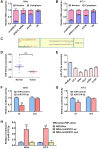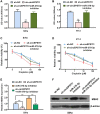circEPSTI1 promotes tumor progression and cisplatin resistance via upregulating MSH2 in cervical cancer
- PMID: 35779530
- PMCID: PMC9320557
- DOI: 10.18632/aging.204152
circEPSTI1 promotes tumor progression and cisplatin resistance via upregulating MSH2 in cervical cancer
Abstract
CircRNAs (circRNAs) are a kind of non-coding RNAs which are extensively distributed in tissues. Previous investigations reported that circRNAs harbor indispensable roles in modulating the progress of multiple cancers. Nevertheless, the function along with the molecular mechanism of most circRNAs in cervical cancer progression was still not clear. Herein, we illustrated that circEPSTI1 is a remarkably upregulated circRNA, which we validated in tissues with cervical cancer along with cell lines. The biological role of circEPSTI1 in the advancement of cervical cancer was probed via loss-of function assessments. Silencing circEPSTI1 could diminish the proliferative capacity of the cervical cancer cells to spread. In cervical cancer cells, silencing circEPSTI1 dramatically elevated drug responsivity to cisplatin. Mechanically, RNA immuno-precipitation experiments and dual luciferase enzyme reporter experiments were conducted to reveal the molecular mechanism of circEPSTI1 in cervical cancer. In conclusion, this research premise identified the biological function of circEPSTI1-miR-370-3p-MSH2 axis in cervical cancer progression. Our result is significant for slowing the progress of and overcoming drug resistance of cervical cancer.
Keywords: MSH2; cervical cancer; circEPSTI1; circular RNAs; cisplatin resistance.
Conflict of interest statement
Figures





Similar articles
-
Recent advances in the role of circRNA in cisplatin resistance in tumors.Cancer Gene Ther. 2025 May;32(5):497-506. doi: 10.1038/s41417-025-00899-4. Epub 2025 Mar 27. Cancer Gene Ther. 2025. PMID: 40148680 Review.
-
Circular RNA circEPSTI1 accelerates cervical cancer progression via miR-375/409-3P/515-5p-SLC7A11 axis.Aging (Albany NY). 2021 Feb 2;13(3):4663-4673. doi: 10.18632/aging.202518. Epub 2021 Feb 2. Aging (Albany NY). 2021. PMID: 33534779 Free PMC article.
-
circEPSTI1 Acts as a ceRNA to Regulate the Progression of Osteosarcoma.Curr Cancer Drug Targets. 2020;20(4):288-294. doi: 10.2174/1568009619666191107140948. Curr Cancer Drug Targets. 2020. PMID: 31702512
-
circEPSTI1 regulates ovarian cancer progression via decoying miR-942.J Cell Mol Med. 2019 May;23(5):3597-3602. doi: 10.1111/jcmm.14260. Epub 2019 Mar 19. J Cell Mol Med. 2019. PMID: 30887698 Free PMC article.
-
Circular RNAs: A novel biomarker for cervical cancer.J Cell Physiol. 2020 Feb;235(2):718-724. doi: 10.1002/jcp.29009. Epub 2019 Jun 25. J Cell Physiol. 2020. PMID: 31240697 Review.
Cited by
-
Human umbilical cord mesenchymal stem cells small extracellular vesicles-derived miR-370-3p inhibits cervical precancerous lesions by targeting DHCR24.Stem Cells Transl Med. 2025 Jan 17;14(1):szae087. doi: 10.1093/stcltm/szae087. Stem Cells Transl Med. 2025. PMID: 39552565 Free PMC article.
-
Circular RNAs in gynecologic cancers: mechanisms and implications for chemotherapy resistance.Front Pharmacol. 2023 Jun 8;14:1194719. doi: 10.3389/fphar.2023.1194719. eCollection 2023. Front Pharmacol. 2023. PMID: 37361215 Free PMC article. Review.
-
The role of long noncoding RNAs in therapeutic resistance in cervical cancer.Front Cell Dev Biol. 2022 Nov 9;10:1060909. doi: 10.3389/fcell.2022.1060909. eCollection 2022. Front Cell Dev Biol. 2022. PMID: 36438563 Free PMC article. Review.
-
Promising predictive molecular biomarkers for cervical cancer (Review).Int J Mol Med. 2024 Jun;53(6):50. doi: 10.3892/ijmm.2024.5374. Epub 2024 Apr 12. Int J Mol Med. 2024. PMID: 38606495 Free PMC article. Review.
-
Recent advances in the role of circRNA in cisplatin resistance in tumors.Cancer Gene Ther. 2025 May;32(5):497-506. doi: 10.1038/s41417-025-00899-4. Epub 2025 Mar 27. Cancer Gene Ther. 2025. PMID: 40148680 Review.
References
-
- Fanfani F, Vizza E, Landoni F, de Iaco P, Ferrandina G, Corrado G, Gallotta V, Gambacorta MA, Fagotti A, Monterossi G, Perrone AM, Lazzari R, Colangione SP, Scambia G. Radical hysterectomy after chemoradiation in FIGO stage III cervical cancer patients versus chemoradiation and brachytherapy: Complications and 3-years survival. Eur J Surg Oncol. 2016; 42:1519–25. 10.1016/j.ejso.2016.05.011 - DOI - PubMed

